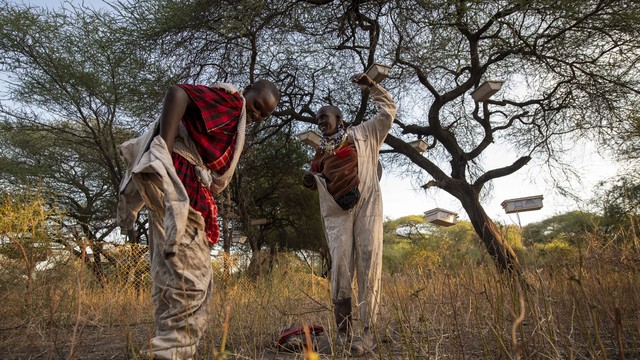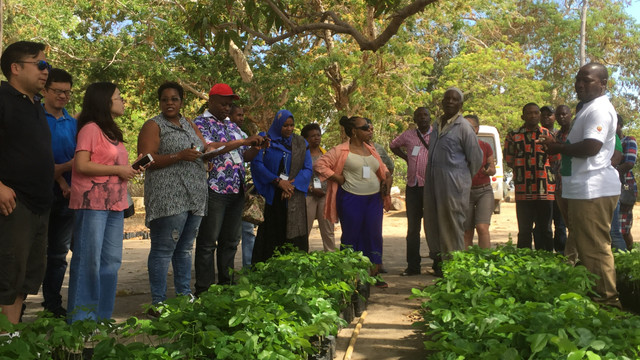Cities into sinks: storing carbon in wooden architecture to mitigate climate change
IIED and partners are exploring how wooden architecture might expand the forest carbon sink to help mitigate climate change while also incentivising smallholder tree-growing to drive forest landscape restoration.

Wooden building in Sweden developed by Swedish architect company Wingardhs, in association with ARVET, the firm designing the Ndarugu Student complex in Kenya (Photo: copyright ARVET Sweden)
With climate change an increasingly pressing global concern, historically unprecedented global emissions reached +58 GtCO2e yr−1 (a lot of carbon) in 2018.
Global carbon sequestration needs to happen faster. And forests are the best current option.
Forests comprise trees that contain lots of carbon. Globally, forests comprise a net carbon sink of −7.6 GtCO2e yr−1, reflecting a balance between gross carbon removals as trees grow (−15.6 GtCO2e yr−1) and gross emissions from deforestation and degradation (+8.1 GtCO2e yr−1).
To put that forest sink in context, forests soak up slightly less than the annual emissions from all global transport at 8.3 GtCO2e yr−1.
But as deforestation continues (including through forest and peatland fires) some of the world’s major forests are turning into net sources of carbon rather than net sinks. In Africa, deforestation is primarily driven by expanding populations of smallholder subsistence farmers, unlike continents such as South America or Asia where the main driver is agro-industrial commodities.
So what can be done to enhance the forest sink, reduce emissions from deforestation and degradation, while also helping African smallholder farmers?
Locking timber into wooden architecture expands the forest carbon sink. Increasing market demand for timber could also, if well governed, incentivise smallholder tree planting at scale.
The growth in African megacities provides an opportunity to explore this possibility. The population of sub-Saharan Africa is projected to triple between 2017 and 2100 to more than three billion.
African cities will feel the pressure. Global estimates show the urban population ballooning from 0.75 billion in 1950 to more than 4 billion today, with African cities taking the global lead in the rate of expansion from 2015–2050.
Construction is one the world’s largest sources of carbon emissions. IIED believes that the climate benefits of new engineered wooden architecture are insufficiently understood as a transformational option for forest-climate action.
There are a wide range of carbon efficient wood, non-wood and hybrid products being developed that open up innovative new solutions. But increasing European and American appreciation of the benefits and competitiveness of conventional and high-rise wooden architecture has not yet reached those governing African megacities - where future urban expansion will happen at pace.
Knowledge gaps remain on quantification of:
- The climate benefits of turning cities into sinks
- The potential rural environmental and livelihood benefits of growing trees to meet affordable housing demand, and
- The investment and governance challenges of doing so.
This project aims to address those knowledge gaps and accelerate understanding of how wooden architecture in urban Africa could be a transformational option for climate action in the continent.
Expanding affordable wooden housing markets in Africa could benefit not only poor urban dwellers, but also incentivise an already booming smallholder tree-grower sector with further rural carbon and livelihood benefits.
What is IIED doing?
IIED is beginning to work in this area and has joined forces with existing Forest and Farm Facility partners in Kenya, together with architectural partners such as Arvet in Sweden, and the business school at the University of Edinburgh. The partners will:
- Develop partnerships that quantify the urban carbon sequestration benefits of wooden architecture projects in Nairobi – as storage, substitute, sink
- Help engage urban planning authorities in Nairobi to co-develop thinking on future urban planning
- Track investment needs to establish engineered wood production capabilities to meet the projections of demand for such wooden architecture
- Help quantify the amount of new tree growing (and associated rural carbon sequestration) that would be needed to supply that value chain from both Kenya and neighbouring Tanzania, and
- Work with tree growers associations, such as Farm Forestry Smallholder Producers Association of Kenya (FF-SPAK) in Kenya and Tanzania Tree Growers Assotiation Union (TTGAU) in Tanzania, to engage with planned pilot schemes to develop supply for timber housing markets.
The development of this fivefold knowledge and capability will be key to encouraging enabling policies and investments in Kenya (and globally).
We aim for all aspects of this work to be collaborative and will respect intellectual property in this initiative and reflect it in authorship of all products developed. The final products will be shared through the IIED Publications Library and circulated through our shareholder networks.



